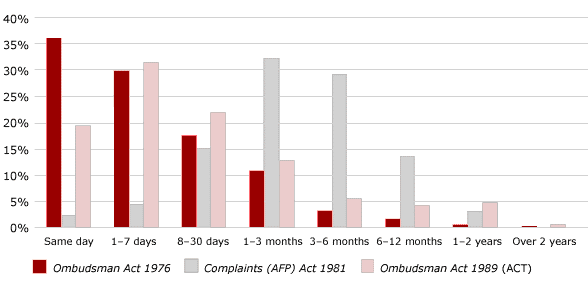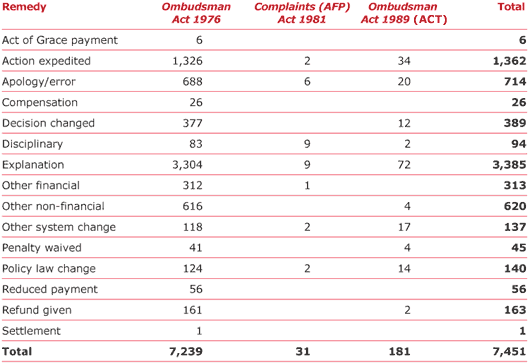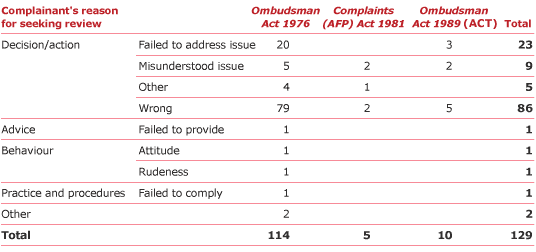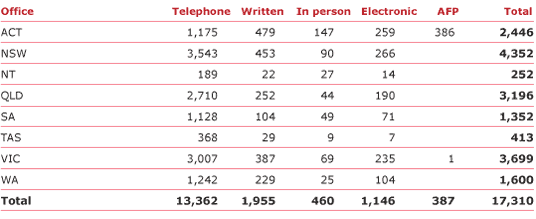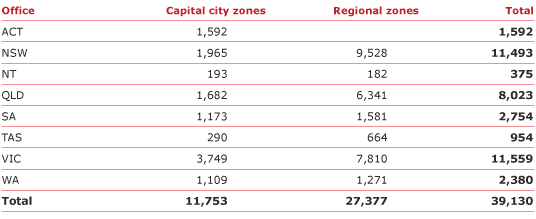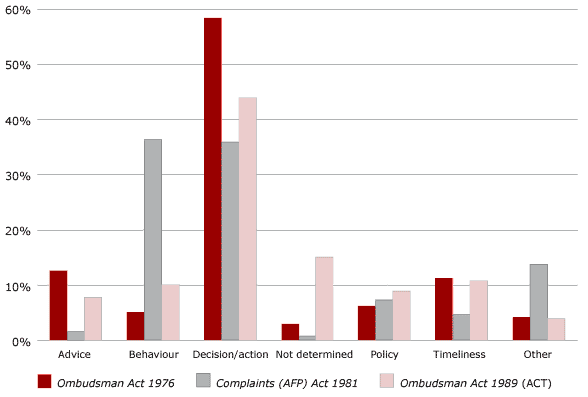Commonwealth Ombudsman Annual Report 2004-05 | Chapter 3


CHAPTER 3 | performance report
Introduction
This chapter of the report details performance in relation to the resources appropriated to the Ombudsman by the Australian Government and agreed outcome and outputs.
The performance framework summarised in the outcome and outputs price and achievements tables (Table 3.1 and Table 3.2) do not cover all of the office's diverse range of activities. A summary of achievements follows the outcome and outputs tables to provide a context for the office's formal reporting requirements.
The role of the Commonwealth Ombudsman is principally performed under the following legislation.
Ombudsman Act 1976 (Cth)
The Commonwealth Ombudsman can consider complaints about almost all Australian Government departments and agencies and some contractors delivering government services to the community. Under this Act, the Commonwealth Ombudsman is also the Defence Force Ombudsman and is empowered to deal with complaints by serving or former members of the Australian Defence Force, and is the Taxation Ombudsman in relation to complaints about the Australian Taxation Office.
Complaints (Australian Federal Police) Act 1981 (Cth)
The Ombudsman has a role in the handling and investigation of complaints against the Australian Federal Police (AFP), in their national and Australian Capital Territory Policing roles.
Ombudsman Act 1989 (ACT)
The Commonwealth Ombudsman is the ACT Ombudsman in accordance with a memorandum of understanding between the Ombudsman and the ACT Government.
Complaints received and finalised about ACT Government departments and agencies are included as part of the Ombudsman's overall complaint-handling numbers. The Ombudsman has provided more detail on the performance of the ACT Ombudsman function in the ACT Ombudsman Annual Report 2004–05 to the ACT Legislative Assembly. This annual report is available at www.ombudsman.act.gov.au.
Performance at a glance
TABLE 3.1 Summary of outcome and outputs price
Outcome Achieve equitable outcomes for complaints from the public and foster improved and fair administration by Australian Government agencies
| Budgeted price of outputs | $13.062m |
| Actual price of outputs | $12.762m |
| Budgeted Departmental appropriations | $11.463m |
| Actual Departmental appropriations | $11.482m |
| Budgeted revenue from other sources | $1.599m |
| Actual revenue from other sources | $1.280m |
[Full details of the total price of agency outputs of the Ombudsman’s office are provided in Note 20
of the Financial Statements of this report.]
TABLE 3.2 Summary of outcome and outputs achievements
OUTPUT 1 Provision of a complaint management service for government

OUTPUT 2 Provision of advice to government to improve public administration
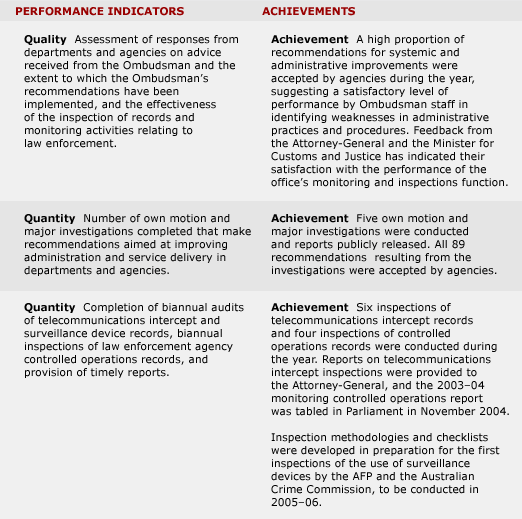
Output 1—Provision of a complaint management service for government
Output 1.1: Feedback and assessment
Performance indicator Feedback from clients and stakeholders on satisfaction with service delivery, timeliness and outcomes, and assessment of quantitative data.
Satisfaction
A client satisfaction survey was conducted in May–June 2004 of 2,000 complainants across all jurisdictions of the Ombudsman's office. Results from client satisfaction surveys conducted in 2000 and 2004 showed a similar satisfaction rate among complainants: 58% of complainants were satisfied with service delivery and 65% were satisfied that the Ombudsman staff did as much as they should have when investigating complaints. When taking into consideration that only 33% of complaint issues are investigated, the latter satisfaction rate of 65% reflects favourably on the work of Ombudsman staff.
The survey results highlighted a number of areas where we can make improvements to our services and training programs to address areas of weakness and to improve consistency. During 2004–05, we reviewed our training requirements and conducted programs for all investigation staff in mediation and alternative dispute resolution, dealing with difficult people, preventing bullying and harassment, and general investigation training.
We also reviewed our procedures for receiving complaints and allocating those complaints to investigation officers. Changes to our work practices and improvements to our computer-based complaints management system will be implemented in the first half of 2005–06.
Timeliness in complaint handling
In 2004–05, 81% of all complaints were finalised within one month of receipt—marginally below previous years and the office's target of 85% for the year.
The percentage of investigated complaints finalised within one month was 65%, compared to 69% in the previous year.
Data from our complaints management system is used to monitor response times by the office and to identify delays in complaint investigation. With many of the complaints we investigate, we need to factor in the time it takes for agencies to provide us with information. Quality assurance is conducted regularly on complaints investigated, with checks conducted for one in four straightforward investigations and for all of the more complex complaints. Monthly statistical reports enable senior management to monitor current issues and trends.
Timeliness in the handling of complaints relating to the Australian Federal Police (AFP) has remained satisfactory this year. The different complaint-handling procedure established by the Complaints Act means that the majority of investigations and conciliations of complaints are first conducted by AFP Professional Standards, followed with a review by the Ombudsman's office. This is necessarily a longer process than for the handling of Ombudsman Act complaints. A total of 83% of all AFP complaints were finalised within six months of receipt (compared to 89% last year).
This year we encountered difficulty in maintaining staffing numbers within the office's Law Enforcement Team, leading to delays in the review and finalisation of some matters. This led to an increase in the percentage of complaints taking three to six months to complete. The filling of staff positions and a workload management strategy implemented in June 2005 will see the backlog of cases reduced by August 2005. We are also continuing to work with the AFP to ensure that delays in AFP responses to complaints are minimised.
The Ombudsman has reported in detail about timeliness in the handling of complaints about Australian Capital Territory agencies and community policing in a separate report as ACT Ombudsman. This report is available at www.ombudsman.act.gov.au.
Figure 3.1 shows the time taken to finalise complaints under the three Acts in 2004–05.
|
Remedies
In 2004–05, as in previous years, the most common remedy for complaints was the provision of a detailed explanation by an agency of its decision or action. This was particularly the case in complaints about police, and reflected the ongoing commitment of the AFP to conciliation of less serious matters. A remedy was provided in 26% of complaints investigated and finalised. A breakdown of remedies by Act is provided in Table 3.3.
|
Note: Complaints can contain a number of issues, each requiring separate investigation and possibly resulting in a number of different remedies.
Service quality
We use both positive and negative feedback from complainants to improve our services and to identify areas needing improvement. We also apply the same principle to our own operations that we espouse for other Australian Government agencies: specifically, if a person is not satisfied with the way in which an investigation has been handled there is a clear-cut procedure by which they can seek an internal review of the matter.
The internal review process offered to complainants is set out in the Commonwealth Ombudsman's Client Service Charter. A more senior officer who was not directly involved in handling the original complaint always carries out internal reviews.
In 2004–05, the office received 129 requests for review, a 20% increase on the number of requests received last year. The total figure is less than 1% of all complaints finalised.
Of the 129 review requests received this year, 91% related to decisions or actions of the office on complaint investigations. The main reasons expressed by complainants for seeking a review were wrong decision/action or advice, failure to address issue and misunderstood issue.
Table 3.4 sets out the reasons expressed by complainants who sought review this year.
|
During the year, 146 reviews were finalised, including 37 review requests received in 2003–04. Of those reviews finalised, the original outcome was affirmed in 119 cases (or almost 81% of reviews). We agreed to conduct additional investigation in 21 reviews, and in six reviews we agreed to change our decision on the original complaint. These review outcomes are summarised in Table 3.5.
|
Note: Of the 146 reviews finalised in 2004–05, 37 requests were from 2003–04.
Output 1.2: Complaints received
Performance indicator Number of complaints received in accordance with long-term trends is expected to be around 20,000, and the number of other approaches from the public is expected to be around 10,000.
During 2004–05, we received a total of 17,310 complaints, compared to 17,496 in the previous year. This was 13% below the estimated figure. The decrease in total complaints received in both 2004–05 and 2003–04 is against the trend over the past few years, in which the number of complaints received has been fairly stable. There has, however, been a steady increase in the number of more complex matters and in complaints raising systemic issues, as detailed in the agency-specific chapters of this report.
'Other approaches' refers to contact by members of the public with the Ombudsman's office that is not recorded as a complaint, such as out of jurisdiction matters and requests for information. There was an increase of 33% to 12,013 in 'other approaches' to the office in 2004–05 compared with the previous year. This was 20% above the estimated performance indicator of 10,000. While it is difficult to attribute this increase to a specific reason, increased awareness of the office in the community through outreach activities and the raised profile of the Ombudsman in relation to immigration detention and ADF matters may have been factors.
The decrease in total complaints received in 2004–05 reflected decreases in a number of areas. There were decreases in complaints received about the Department of Transport and Regional Services (down 66%, albeit off a relatively small base), the Australian Taxation Office (down 5%), Centrelink (down 5%), and the AFP (down 2%).
This decrease was offset by an increase in complaints received about the Department of Employment and Workplace Relations (up 19% from a small base), Australia Post (up 10%) and the Child Support Agency (up 7%).
The decrease in the total number of complaints received during 2004–05 (and during 2003–04) may reflect the effort some of the larger departments and agencies have put into improving internal complaint-handling processes. This may also explain the increasing average complexity of complaints being handled by the Ombudsman's office and the length of time required to investigate and finalise complaints (as more of the simple complaints are handled by the agencies).
There was an increase of 12% in the number of complaints lodged electronically, with 1,146 complaints being received by this method; and an increase of 18% in the number of complaints lodged in person. Opportunities for better collection of electronic complaints were evaluated in 2004–05 as part of the office's website redevelopment, which is due to be completed by November 2005.
Table 3.6 details complaints and approaches received in 2004–05 by Act and office receiving, and Table 3.7 details complaints by method received.
|
|
Note: The AFP's Professional Standards team notifies the Ombudsman about complaints it receives for Ombudsman staff to oversee the AFP's complaint-handling process.
National complaints line
In 2004–05, the office received a total of 39,130 telephone calls to its 1300 national complaints number, an increase of 21% on last year. The number of telephone calls received reported in our 2003–04 annual report (27,160) was incorrect—the correct number was 32,389. We receive this information from a third-party data source and found the discrepancy when checking trend information for this year's report.
The number of telephone calls received equates to an average of 155 calls per day. On average, 70% of calls were from regional areas of Australia and 30% from inside the capital city zones. Table 3.8 provides detail.
|
Complaints by agency
In 2004–05, complaints about the Australian Taxation Office (ATO), Centrelink and the Child Support Agency accounted for 66% (11,426 complaints) of the total number of complaints received, down 2% from last year.
There was a decrease of 5% in complaints received about the ATO, as mentioned above. This is the fifth consecutive year that numbers of complaints about the ATO have fallen, reflecting the 'bedding down' of the new tax system and also the settlement opportunity for mass-marketed scheme investors. These factors are discussed in more detail in the 'Looking at the agencies' chapter of this report.
We received 873 complaints about the Department of Immigration and Multicultural and Indigenous Affairs (DIMIA), compared to 865 in the previous year.
There was an increase of 10% in complaints received about Australia Post. While the high volume of successful postal transactions completed by Australia Post needs to be acknowledged, this is a notable increase in complaints.
Charts comparing complaint trends over the past six years for those agencies against which the most complaints to the Ombudsman are made are included in the 'Looking at the agencies' chapter of this report.
Output 1.3: Complaints finalised and investigated
Performance indicator Number of complaint issues finalised is expected to be approximately 20,000, and number of complaint issues investigated and finalised is expected to be around 6,500.
This year, the Ombudsman's office finalised 17,441 complaints nationally, compared to 17,418 in 2003–04. Complaints made to the Ombudsman often include more than one issue. For example, a complainant may allege that a decision was not only wrong substantively, but also that the agency failed to provide accurate advice, was unreasonably slow, or that client service staff of the agency displayed an inappropriate attitude. Similarly, different issues within the same complaint may result in different actions by the Ombudsman's office. In the example above, the office may suggest that the complainant pursue internal review mechanisms with respect to the agency's substantive decision, but may investigate the issues around delay and service delivery. It is for this reason that the Ombudsman's office reports on complaint issues finalised.
In 2004–05, 18,939 issues were finalised, arising from the 17,441 complaints finalised. Of the issues finalised, the Ombudsman's office investigated 33%, compared to 30% in the previous year. The remaining 67% of complaint issues were finalised usually by the complainant being referred to the internal complaint processes of the agency or investigation of the complaint being found not to be warranted.
Of the complaint issues investigated and finalised, some agency error or deficiency was identified in 14% of complaints (compared to 20% last year). No error or deficiency was identified in 43% of instances (the same as last year). In the remaining 43% of issues investigated, complaints were resolved without the need to determine whether or not the cause of the problem related to administrative deficiency, and no determination about the agency's performance was made. Full details of investigation outcomes may be found in the 'Statistics' appendix of this report.
Causes of complaint
Following an established trend, the majority (58%) of the complaint issues finalised by the Ombudsman's office under the Ombudsman Act 1976 this year related to the correctness or propriety of a decision or action of an agency. The remainder of the complaint issues finalised were about procedural matters, such as timeliness of agency action, or the accuracy or completeness of advice given by agencies. This is similar to the trend over the past four years. Only 5% of complaints were about the conduct of officers in agencies.
There is a different pattern in the complaints about the AFP (see Figure 3.2). Of the complaint issues finalised this year, 36% arose from the conduct of AFP members, including complaints about attitude, assault and incivility. A further 36% arose from police decisions or actions.
|
Note: Complaints (AFP) Act 1981—'Other' includes actions of the AFP concerning disclosure of information, property, and use of vehicles and weapons.
Decisions not to investigate
In order to understand the outcomes of complaints, it is necessary to understand the discretionary powers available to the Ombudsman.
The legislation administered by the Ombudsman confers upon the office a range of discretionary powers not to investigate matters in particular circumstances. Examples of cases where the Ombudsman can decline to investigate a matter include where it is more than 12 months old; if the complainant does not have a sufficient interest in the subject matter of the complaint; if a complainant has not first raised the complaint with the agency; or there is a more appropriate alternative avenue of review available to the complainant.
In a practical sense, the most important of these powers is the discretion to decide not to investigate until a complainant has first raised the complaint with the agency. The rationale for deciding not to investigate is that matters in dispute should first be raised and clarified at the source of the problem. In 2004–05, 40% of issues raised in complaints to the Ombudsman were dealt with in this way, compared to 43% in the previous year.
Complaints carried forward
The total number of complaints carried forward (past 30 June 2005) was 1,137, compared to 1,207 at the end of the reporting period in the previous year, a decrease of 6% for this year. This backlog can generally be attributed to the complexity of the complaints and the correspondingly longer period of time required to investigate those complaints.
Output 2—Provision of advice to government to improve public administration
Output 2.1: Improvements to government administration and recommendations implemented
Performance indicator Assessment of responses from departments and agencies on advice received from the Ombudsman and the extent to which the Ombudsman's recommendations have been implemented, and the effectiveness of the inspection of records and monitoring activities relating to law enforcement.
A high proportion of recommendations for systemic and administrative improvements were accepted by agencies during the year, suggesting a satisfactory level of performance by Ombudsman staff in identifying weaknesses in administrative practices and procedures.
The Ombudsman's office recognises that, if a complainant is to be referred back to an agency, it is vital that the agency has an effective internal complaint-handling mechanism in place. Each year the office gives a high priority to monitoring agency complaint handling and to working closely with agencies to assist them to improve their internal complaint-handling procedures. During 2004–05, we continued a review into the complaint-handling mechanisms employed by the Department of Transport and Regional Services. The department developed new complaint procedures within its Vehicle Standards Safety Branch and initiated a review of internal complaint-handling procedures in other areas during the year.
In 2005, we commenced a pilot project to test the effectiveness of our complaint referral process to the ATO. We are surveying a sample of complainants whom we referred back through the ATO complaints system to obtain feedback on whether the advice we provided was useful in progressing their complaints. The results of the survey will assist us to improve the effectiveness of our complaint referral process. Further targeted sample studies will be conducted in 2005–06 to gauge the effectiveness of this referral activity.
The notion that complaint handling should first be addressed by the agency concerned is also recognised in other formal ways in the legislation establishing the Commonwealth Ombudsman. Examples are complaints about the AFP that are ordinarily investigated in the first instance by AFP Professional Standards; and complainants in the Defence jurisdiction, who must first pursue the formal Redress of Grievance processes under the Defence Act 1903, other than in exceptional circumstances.
Most of the investigation work of the Ombudsman's office occurs where there is no alternative avenue of resolution available to a person, because of either their circumstances or those of the particular complaint; there is an indication of a systemic problem in government administration, likely to affect a number of people; or where a complainant remains dissatisfied with the outcome of their treatment, despite a review having already been undertaken by an agency.
Throughout the year, the Ombudsman provided reports to the Attorney-General under the Telecommunications (Interception) Act 1979 (the TI Act) and to the Minister for Justice and Customs in relation to inspections undertaken in accordance with the Crimes Act 1914 (the Crimes Act). A report of our activities in inspecting controlled operations was tabled in Parliament in November 2004. Feedback from the Attorney-General and the Minister for Customs and Justice has indicated satisfaction with the performance of the office in relation to the inspection of records and monitoring activities relating to law enforcement.
Output 2.2: Formal recommendations arising from investigations
Performance indicator Number of own motion and major investigations completed that make recommendations aimed at improving administration and service delivery in departments and agencies.
During the year, the Ombudsman publicly released reports on seven own motion and major investigations. Two of the investigations (which related to the Tax Agents' Board of NSW and the ATO) were completed and provided to the agency in 2003–04, and were reported in last year's annual report. These reports are available at www.ombudsman.gov.au.
Of the five own motion and major investigations finalised and released publicly in 2004–05, all of the 89 recommendations in the investigation reports were accepted by agencies. The investigations comprised:
- October 2004—Complaint against the Australian Defence Force by a young person (under the age of 18 years) about an incident involving unacceptable behaviour at a Navy training establishment in mid-1996
- November 2004—The Australian Crime Commission's implementation of recommendations arising from a review of the corporate and operational implications for the commission arising from alleged criminal activity by two former secondees. (This publication by the Commonwealth Ombudsman is different from other reports. It does not contain any recommendations to correct deficient administrative action but is thought worthy of inclusion in this report series.)
- December 2004—Complaint against DIMIA about delay in the processing of an application for a bridging visa
- April 2005—Review of the Australian Defence Force Redress of Grievance System (a joint report by the Department of Defence and the Commonwealth Ombudsman)
- May 2005—Complaint against DIMIA by Mr Z about his immigration detention.
Several own motion investigations are currently being conducted and will be completed in 2005–06.
Under powers conferred by the Complaints Act, Ombudsman staff worked on four special investigations relating to the AFP. Two investigations were completed, with the other two investigations to be completed in 2005–06.
The high incidence of departments and agencies accepting Ombudsman formal recommendations for systemic and administrative improvements suggests a highly satisfactory level of performance in identifying opportunities for improvement in administrative practices and procedures during 2004–05.
The most significant constraint on performance in this area is the high level and volume of resources that major investigations require. The challenge is to manage the balance between the urgent and immediate pressures of individual complaints and the broader gains achievable by careful targeting of major issues.
Output 2.3: Feedback on auditing and monitoring activities
Performance indicator Completion of biannual audits of telecommunications intercept and surveillance device records, biannual inspections of law enforcement agency controlled operations records, and provision of timely reports.
Telecommunications intercept records
Under the TI Act, the Ombudsman is required to inspect the records of the AFP and the ACC to ensure that they conduct telecommunications interception activities in accordance with the provisions of the Act.
The AFP and ACC regularly consult and liaise with Ombudsman staff on issues such as training and development, current and emerging issues and our expectations of their staff concerning the administration of telecommunication interception warrants.
Ordinarily, two inspections of each agency are carried out each year, but in 2004–05 three inspections were conducted because of a change in practice within the office concerning the inspection period covered by a report. Three inspections were conducted at the AFP (including a regional inspection) and three at the ACC.
These inspections continue to form a core element of the work of the Ombudsman's Inspections Team. The inspection methodology used and resource levels required are regularly reviewed to ensure that the accountability role of the office continues to be met.
Surveillance device and compliance powers records
The Ombudsman's monitoring role expanded during 2004–05 with passage of the Surveillance Devices Act 2004 and amendments to the Workplace Relations Act 1996.
The initial inspections of the use of surveillance devices by members of the AFP and ACC, and the use of compliance powers by members of the Building Industry Taskforce, will be conducted in the first half of 2005–06. Inspection methodologies and checklists were developed during 2004–05 in preparation for the first inspections of surveillance device records.
Controlled operations records
During the year, Ombudsman staff conducted a total of four inspections of controlled operations records. Two inspections were conducted at the AFP and two inspections at the ACC. These inspections resulted in reports to both agencies and the Minister for Customs and Justice, and the presentation of a report to Parliament in December 2004. The reports concluded that the agencies are generally complying with the requirements of the Crimes Act and providing comprehensive information in formal reports.
Following a briefing by the Ombudsman to the Parliamentary Joint Committee on the ACC in October 2003, an own motion investigation was initiated into record keeping related to ACC controlled operations authorised under State or Territory legislation.
Ombudsman staff reviewed the application, authorisation and record-keeping practices of the ACC for all jurisdictions in which ACC controlled operations occurred. There was no basis to criticise the ACC for the way in which it was handling controlled operations under State laws.
